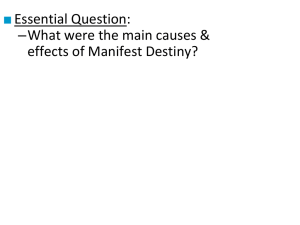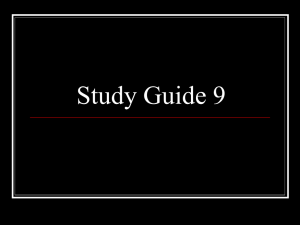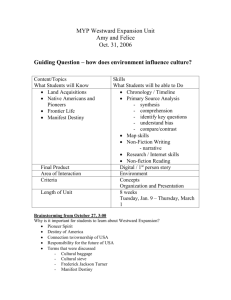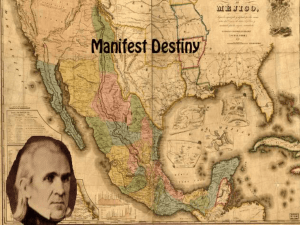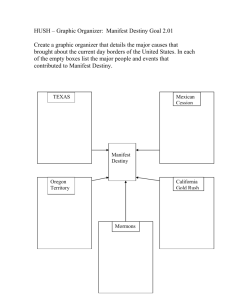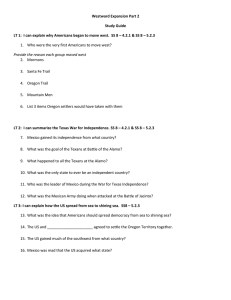Unit Five PPT 1
advertisement
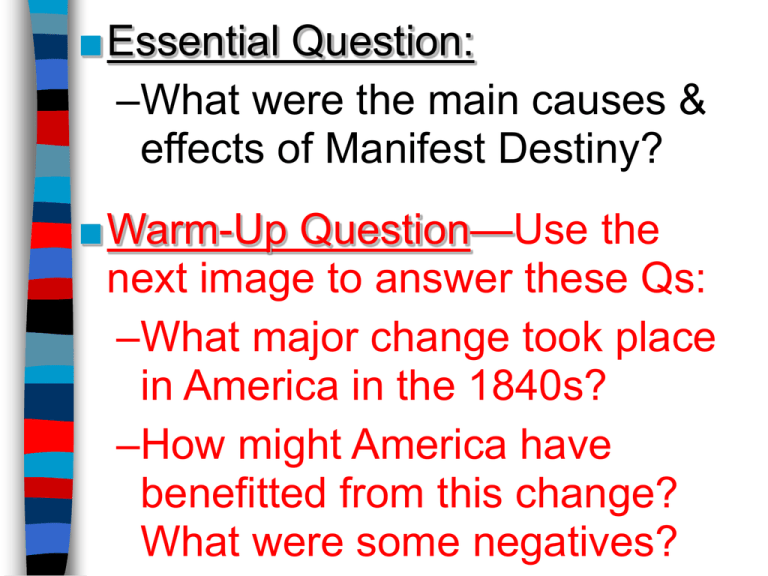
■Essential Question: –What were the main causes & effects of Manifest Destiny? ■Warm-Up Question—Use the next image to answer these Qs: –What major change took place in America in the 1840s? –How might America have benefitted from this change? What were some negatives? What changed in the 1840s? Use this image to search for clues: What major change occurred in America in the 1840s? ■ The period of time in U.S. history before the Civil War is known as the Antebellum Era (1800-1860) –Early Antebellum (1800-1840) • American nationalism • Age of the “common man” • Industrial revolution, rise of “king cotton,” market economy –Late Antebellum (1840-1860) • Manifest Destiny into the West • Sectionalism divided North & South Image Analysis ■ Examine the image on the next slide & answer these questions: –What point might the artist be making about the American West? –What type of American traveled West? Was this an easy journey? –Why would Americans make the journey into the West? “Westward the Course of Empire” by Emanuel Leutze Primary Source Analysis: Manifest Destiny ■ Use the following primary sources to answer these questions: –What do the terms “manifest” & “destiny” mean? –What were the perceived benefits of this westward expansion? –How did Americans justify their westward expansion? “The whole continent appears to be destined...to be peopled by one nation. The acquisition of a definite line of boundary to the [Pacific] forms a great epoch in our history.” John Quincy Adams, 6th President of (18251829), written in 1811 “...It is confidently believed that our system may be safely extended to the utmost bounds of our territorial limits, and that as it shall be extended the bonds of our Union, so far from being weakened, will become stronger...” From the inaugural address of James K. Polk, 11th President (1845-49) “The American claim is by the right of our manifest destiny to overspread and to possess the whole of the continent which Providence has given us for the development of the great experiment of liberty and federative self-government entrusted to us. It is a right such as that of the tree to the space of air and earth suitable for the full expansion of its principle and destiny of growth...It is in our future far more than in the past history of Spanish exploration or French colonial rights, that our True Title is to be found” Journalist John L. O' Sullivan, New York Morning News (1845) Manifest Destiny ■In the 1840s, westward expansion “Obvious” “Future” led Americans to acquire all lands from the Atlantic to Pacific in a movement called Manifest Destiny –Americans flooded into the West for new economic opportunities –The U.S. gained Texas, Oregon, California, & other territories through treaty or war Reasons for Manifest Destiny ■Changes in the early Antebellum era (1800-1840), encouraged westward expansion in the 1840s –Jefferson’s Louisiana Purchase doubled the sizein of the the 1840s USA What changed encouraged –Lewis that & Clark’s exploration confirmed the expansion? economic westward potential of the western territory When Americans were colonists (1607-1783), the western border was the Appalachian Mountains After the Revolutionary War, the western border of the U.S. was the Mississippi River After Jefferson’s Louisiana Purchase in 1803, the western border was the Rocky Mountains By 1850, the western border was the Pacific Ocean from Oregon to California Reasons for Manifest Destiny ■Changes in the early Antebellum era (1800-1840), encouraged westward expansion in the 1840s –The growth of “King Cotton” & commercial farming led to a desire for more western lands –Improved transportation such as canals, steamboats, & railroads increased speed & profitability Reasons for Manifest Destiny ■Changes in the early Antebellum era (1800-1840), encouraged westward expansion in the 1840s –The U.S. population grew 300% –The number of U.S. states grew from 13 to 26 –Western state populations exploded (Ohio’s population grew from 50,000 to 1.5 million) Motivations of Westward Expansion ■The journey West was dangerous & unpredictable, yet thousands of Americans traveled along the Oregon, Santa Fe, & Mormon Trails –The earliest pioneers were fur traders, land speculators, & poor Why would pioneers risk farmers looking for cheap land their lives to travel West? –Soon, farmers, miners, ranchers, & religious groups flooded West Joseph Smith’s murder forced new LDS leader Western Trails Brigham Young to resettle in Salt Lake, Utah where heSanta built aFeMormon community The Trail allowed the U.S. to sell goods to Mexico The In 1830, Oregon Joseph TrailSmith led thousands founded of thefarmers Mormon to Church the fertile of Latter-day lands of Oregon Saintsin inthe New 1840s York, but were persecuted & forced to move West Westward Expansion Westward expansion brought conflict with The Treaty of Fort Laramie createdWar, a Indians, such as the Black Hawk vast Territory hunting but was grounds repeatedly asIndian trails disrupted & ignored whites expanding West violatedby previous treaty agreements What is Manifest Destiny? ■ Examine the image on the next slide & answer the following questions: –Identify 3 reasons Americans moved West –Identify 3 consequences of American westward expansion –What does the women in the center of the image represent? –What point is the artist trying to make with his use of light? What was the journey west across the Oregon Trail like? “Life on the Oregon Trail” Excerpt #1 “Pioneers along the Oregon Trail averaged 15 miles per day, almost exclusively on foot, for nearly 6 months” “Life on the Oregon Trail” Excerpt #2 “Covered wagons dominated traffic on the Oregon Trail. The typical wagon was about 11 feet long, 4 feet wide, and 2 feet deep, with bows of hardwood supporting a bonnet that rose about 5 feet above the wagon bed. With only one set of springs under the driver's seat and none on the axles, nearly everyone walked along with their herds of cattle and sheep.” “Life on the Oregon Trail” Excerpt #3 “A typical day started before dawn with breakfast of coffee, bacon, and dry bread. The wagon was repacked in time to get underway by 7 o'clock. At noon, they stopped for a cold meal of coffee, beans, and bacon. Then back on the road again. Around 5 in the afternoon, they circled the wagons for the evening. The men secured the animals and made repairs while women cooked a hot meal of tea, boiled rice, and bacon” “Life on the Oregon Trail” Excerpt #4 “When the Trail got crowded (in 1849 and later) camping became more difficult. The biggest problem was finding fuel for the campfires. Soon trees were scarce and there was only one alternative: buffalo dung. No one liked collecting it, but it did burn and gave off a consistent odorless flame” “Life on the Oregon Trail” Excerpt #5 “Weather-related dangers included thunderstorms, hailstones, lightning, tornadoes, & high winds. The intense heat of the deserts caused wood to shrink & rims to fall of axles. The pioneers’ lips blistered and split in the dry air, and their only remedy was to rub axle grease on their lips. River crossings were often dangerous: even in slow currents & shallow water, wagon wheels could be damaged by rocks or become mired in the muddy bottom.” “Life on the Oregon Trail” Excerpt #6 “Nearly 1 in 10 who set off on the Oregon Trail did not survive. The two biggest causes of death were disease and accidents. The worst disease was cholera, caused by unsanitary conditions. People in good spirits in the morning could be dead by evening. Symptoms started with an intense stomach ache, then came diarrhea and vomiting causing dehydration. If death did not occur within the first 12 to 24 hours, the victim usually recovered” “Life on the Oregon Trail” Excerpt #7 “Indians were usually the least of the pioneers’ problems. Tales of hostile encounters far overshadowed actual incidents. Indian conflicts occasionally resulted from trigger-happy emigrants who shot at Indians for target practice. A few massacres were highly publicized. The Ward Train was attacked by Shoshones who tortured & murdered 19 emigrants”
